Welding Bead Inspection Using Image and Multi-Sensor Fusion
Abstract
:1. Introduction
2. Related Works
3. Proposed Algorithm
4. Experimental Results
4.1. Experiment Setups
4.2. Experiment Results
5. Conclusions
Author Contributions
Funding
Institutional Review Board Statement
Informed Consent Statement
Data Availability Statement
Conflicts of Interest
References
- Kurt, H.I.; Oduncuoglu, M.; Yilmaz, N.F.; Ergul, E.; Asmatulu, R. A comparative study on the effect of welding parameters of austenitic stainless steels using artificial neural network and Taguchi approaches with ANOVA analysis. Metals 2018, 8, 326. [Google Scholar] [CrossRef]
- Kim, M.S.; Shin, S.M.; Kim, D.H.; Rhee, S.H. A study on the algorithm for determining back bead generation in GMA welding using deep learning. J. Weld. Join. 2018, 36, 74–81. [Google Scholar] [CrossRef]
- Kim, J.H.; Ko, M.H.; Ku, N.K. A Study on Resistance Spot Welding Failure Detection Using Deep Learning Technology. J. Comp. Des. Eng. 2019, 24, 161–168. [Google Scholar]
- Hwang, I.S.; Yoon, H.S.; Kim, Y.M.; Kim, D.C.; Kang, M.J. Prediction of irregular condition of resistance spot welding process using artificial neural metwork. In Proceedings of the 2017 Fall Conference of Society for The Korean Welding & Joining Society, Daegu, Republic of Korea, 30 November 2017. [Google Scholar]
- Kang, J.H.; Ku, N.K. Verification of Resistance Welding Quality Based on Deep Learning. J. Soc. Nav. Archit. Korea 2019, 56, 473–479. [Google Scholar] [CrossRef]
- Ji, T.; Mohamad Nor, N. Deep Learning-Empowered Digital Twin Using Acoustic Signal for Welding Quality Inspection. Sensors 2023, 23, 2643. [Google Scholar] [CrossRef]
- Gao, Y.; Zhao, J.; Wang, Q.; Xiao, J.; Zhang, H. Weld bead penetration identification based on human-welder subjective assessment on welding arc sound. Measurement 2020, 154, 107475. [Google Scholar] [CrossRef]
- Horvat, J.; Prezelj, J.; Polajnar, I.; Cudina, M. Monitoring Gas Metal Arc Welding Process by Using Audible Sound Signal. J. Mech. Eng. 2011, 57, 267–278. [Google Scholar] [CrossRef]
- Wang, Z.; Liu, Y. Active contour model by combining edge and region information discrete dynamic systems. Adv. Mech. Eng. 2017, 9, 1–10. [Google Scholar] [CrossRef]
- Ma, J.; Wang, D.; Wang, X.P.; Yang, X. A Fast Algorithm for Geodesic Active Contours with Applications to Medical Image Segmentation. arXiv 2020, arXiv:2007.00525. [Google Scholar]
- Yin, X.X.; Jian, Y.; Zhang, Y.; Zhang, Y.; Wu, J.; Lu, H.; Su, M.Y. Automatic breast tissue segmentation in MRIs with morphology snake and deep denoiser training via extended Stein’s unbiased risk estimator. Health Inf. Sci. Syst. 2021, 9, 16. [Google Scholar] [CrossRef]
- Mlyahilu, J.; Kim, Y.B.; Lee, J.E.; Kim, J.N. An Algorithm of Welding Bead Detection and Evaluation Using and Multiple Filters Geodesic Active Contour. JKICSP 2021, 22, 141–148. [Google Scholar]
- Mlyahilu, J.N.; Mlyahilu, J.N.; Lee, J.E.; Kim, Y.B.; Kim, J.N. Morphological geodesic active contour algorithm for the segmentation of the histogram-equalized welding bead image edges. IET Image Process. 2022, 16, 2680–2696. [Google Scholar] [CrossRef]
- Wu, H.; Liu, Y.; Xu, X.; Gao, Y. Object Detection Based on the GrabCut Method for Automatic Mask Generation. Micromachines 2022, 13, 2095. [Google Scholar] [CrossRef]
- Saranya, M.P.; Praveena, V.; Dhanalakshmi, M.B.; Karpagavadivu, M.K.; Chinnasamy, P. Diagnosis of gastric cancer using mask R–CNN and Grabcut segmentation method. J. Posit. Sch. Psychol. 2022, 6, 203–206. [Google Scholar]
- Lee, J.; Choi, H.; Kim, J. Inspection Algorithm of Welding Bead Based on Image Projection. Electronics 2023, 12, 2523. [Google Scholar] [CrossRef]
- Wazarkar, S.; Keshavamurthy, B.N.; Hussain, A. Region-based segmentation of social images using soft KNN algorithm. Procedia Comput. Sci. 2018, 125, 93–98. [Google Scholar] [CrossRef]
- Rangel, B.M.S.; Fernández, M.A.A.; Murillo, J.C.; Ortega, J.C.P.; Arreguín, J.M.R. KNN-based image segmentation for grape-vine potassium deficiency diagnosis. In Proceedings of the 2016 IEEE International Conference on Electronics, Communica-tions and Computers (CONIELECOMP), Cholula, Mexico, 24–26 February 2016; pp. 48–53. [Google Scholar]
- Hossain, E.; Hossain, M.F.; Rahaman, M.A. A color and texture based approach for the detection and classification of plant leaf disease using KNN classifier. In Proceedings of the 2019 International Conference on Electrical, Computer and Communication Engineering (ECCE), Cox’sBazar, Bangladesh, 7–9 February 2019; pp. 1–6. [Google Scholar]
- Prabu, S. Object Segmentation Based on the Integration of Adaptive K-means and GrabCut Algorithm. In Proceedings of the IEEE 2022 International Conference on Wireless Communications Signal Processing and Networking (WiSPNET), Chennai, India, 24–26 March 2022; pp. 213–216. [Google Scholar]
- Nasor, M.; Obaid, W. Segmentation of osteosarcoma in MRI images by K-means clustering, Chan-Vese segmentation, and iterative Gaussian filtering. IET Image Process. 2021, 15, 1310–1318. [Google Scholar] [CrossRef]
- Hassan, M.R.; Ema, R.R.; Islam, T. Color image segmentation using automated K-means clustering with RGB and HSV color spaces. J. Comput. Sci. Technol. 2017, 17, 26–33. [Google Scholar]
- Qiao, D.; Zhang, X.; Ren, Y.; Liang, J. Comparison of the Rock Core Image Segmentation Algorithm. In Proceedings of the 2022 IEEE 7th International Conference on Image, Vision and Computing (ICIVC), Xi’an, China, 26–28 July 2022; pp. 335–339. [Google Scholar]
- Debelee, T.G.; Schwenker, F.; Rahimeto, S.; Yohannes, D. Evaluation of modified adaptive k-means segmentation algorithm. Comput. Vis. Media. 2019, 5, 347–361. [Google Scholar] [CrossRef]
- Zheng, X.; Lei, Q.; Yao, R.; Gong, Y.; Yin, Q. Image segmentation based on adaptive K-means algorithm. EURASIP J. Image Video Process. 2018, 1, 68. [Google Scholar] [CrossRef]
- Khrissi, L.; El Akkad, N.; Satori, H.; Satori, K. Clustering method and sine cosine algorithm for image segmentation. Evol. Intell. 2022, 15, 669–682. [Google Scholar] [CrossRef]
- Baek, J.W.; Kong, S.G. Faster R-CNN Classifier Structure Design for Detecting Weld Surface Defects. In Proceedings of the KIIT Conference, Washington, DC, USA, 27–28 July 2018; pp. 149–152. [Google Scholar]
- Haffner, O.; Kučera, E.; Drahoš, P.; Cigánek, J. Using Entropy for Welds Segmentation and Evaluation. Entropy 2019, 21, 1168. [Google Scholar] [CrossRef]
- Kim, T.W.; Han, C.M.; Choi, H.W. Welding Quality Inspection using Deep Learning. In Proceedings of the KSMPE Conference, Tongyeong, Republic of Korea, 25–26 June 2020; p. 18. [Google Scholar]
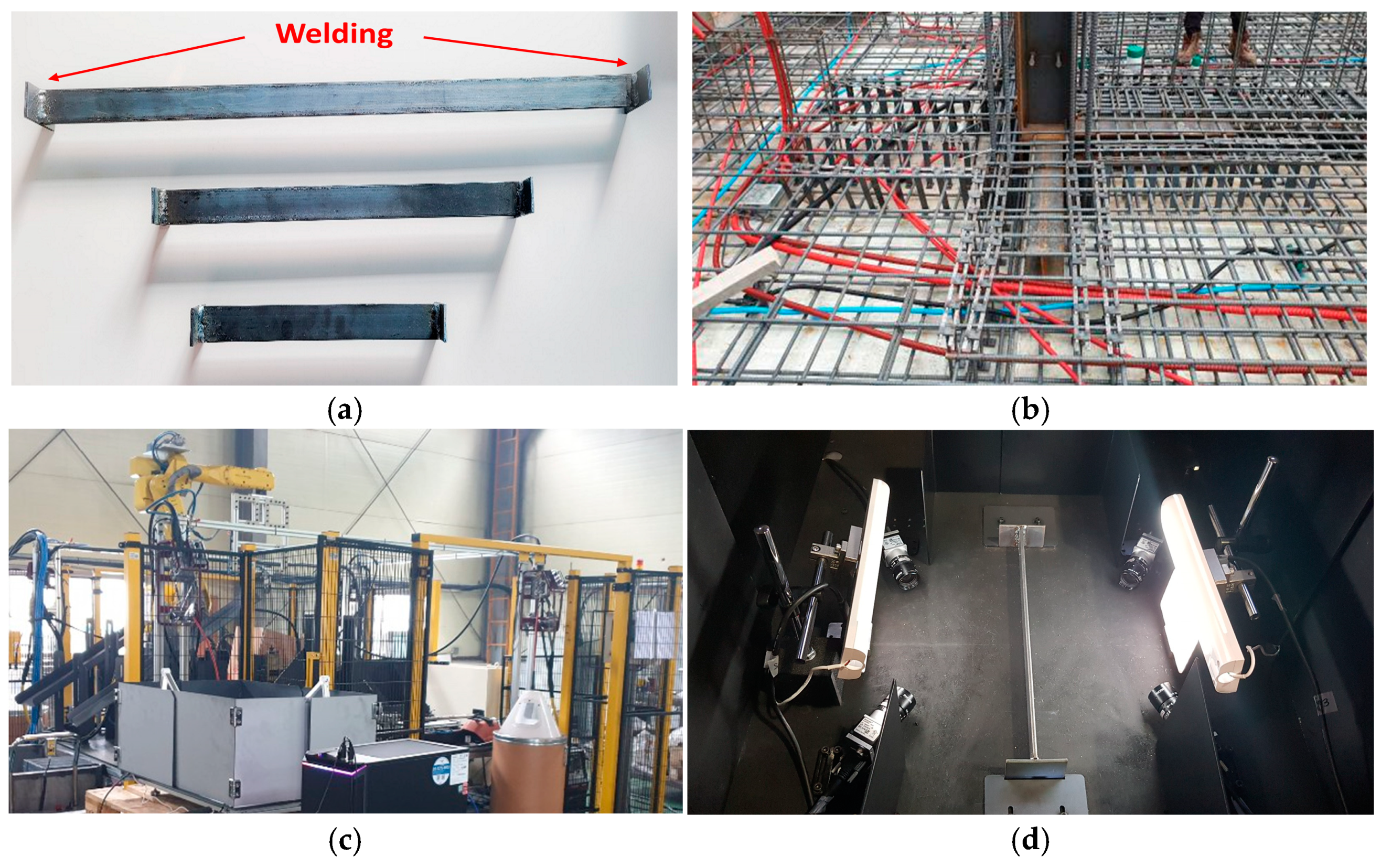

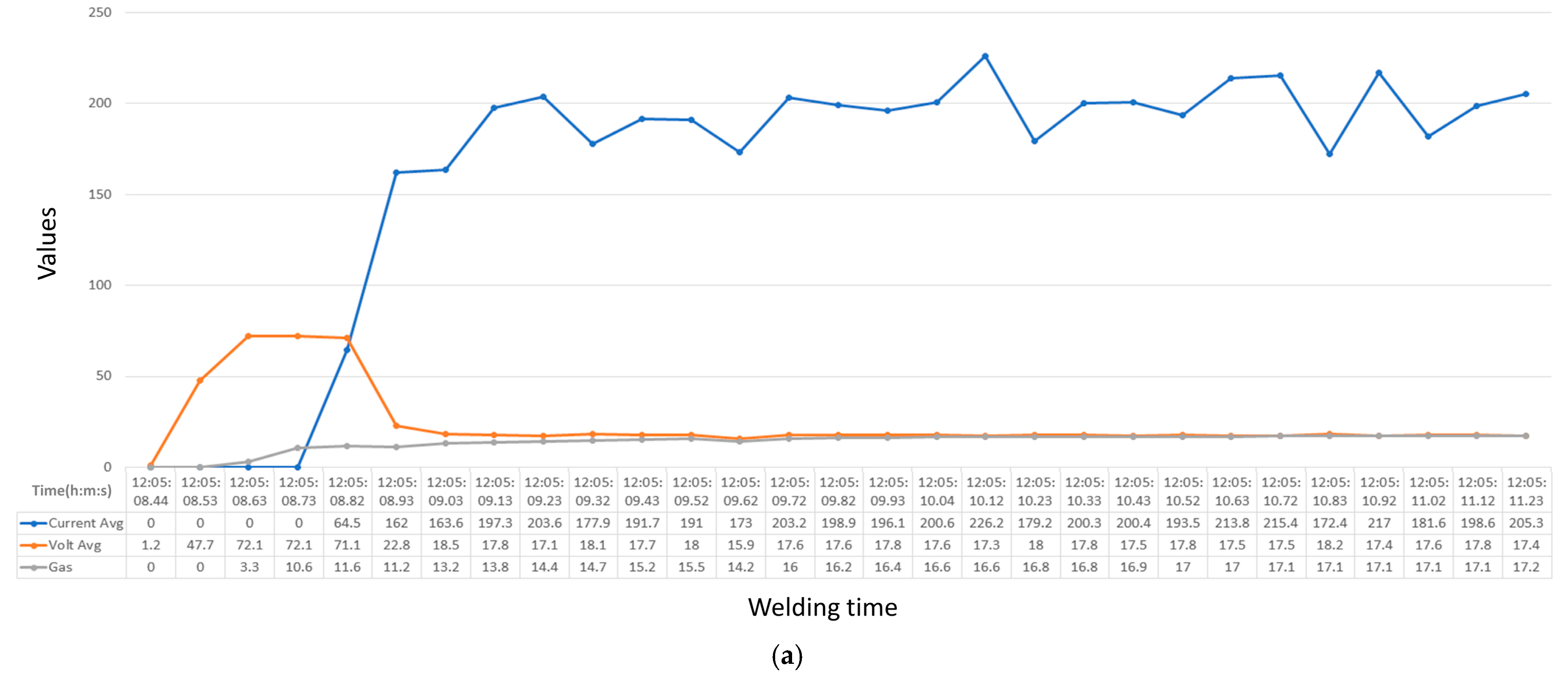

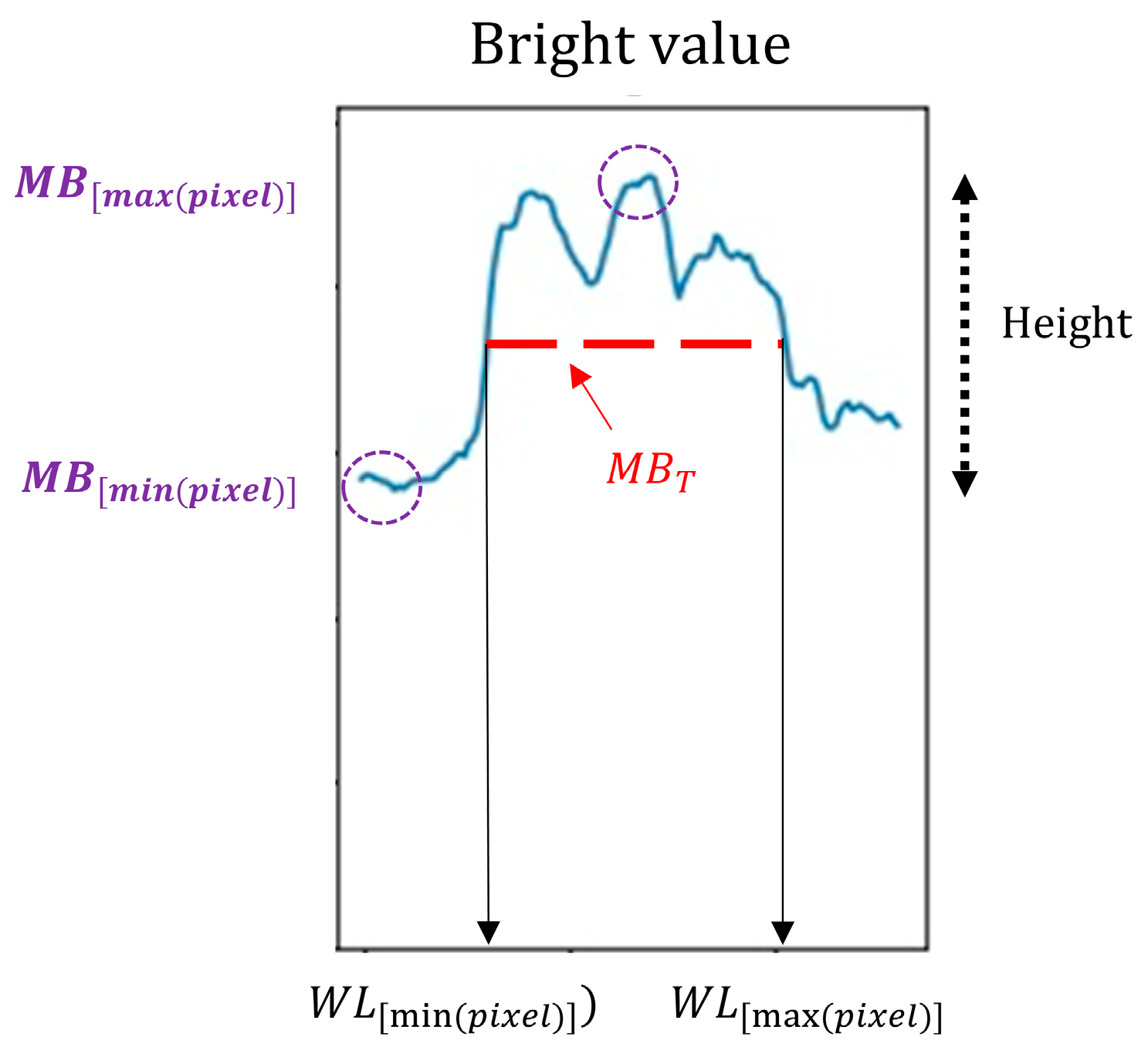
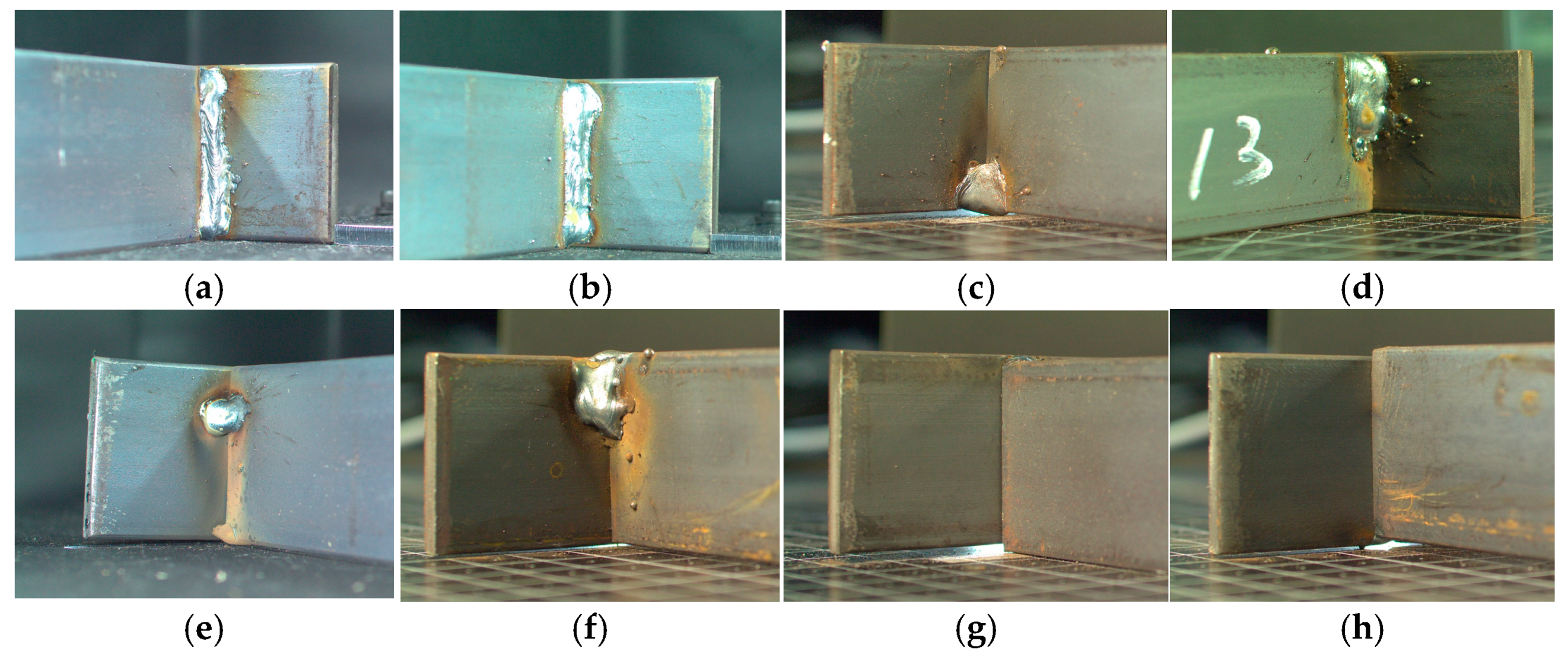
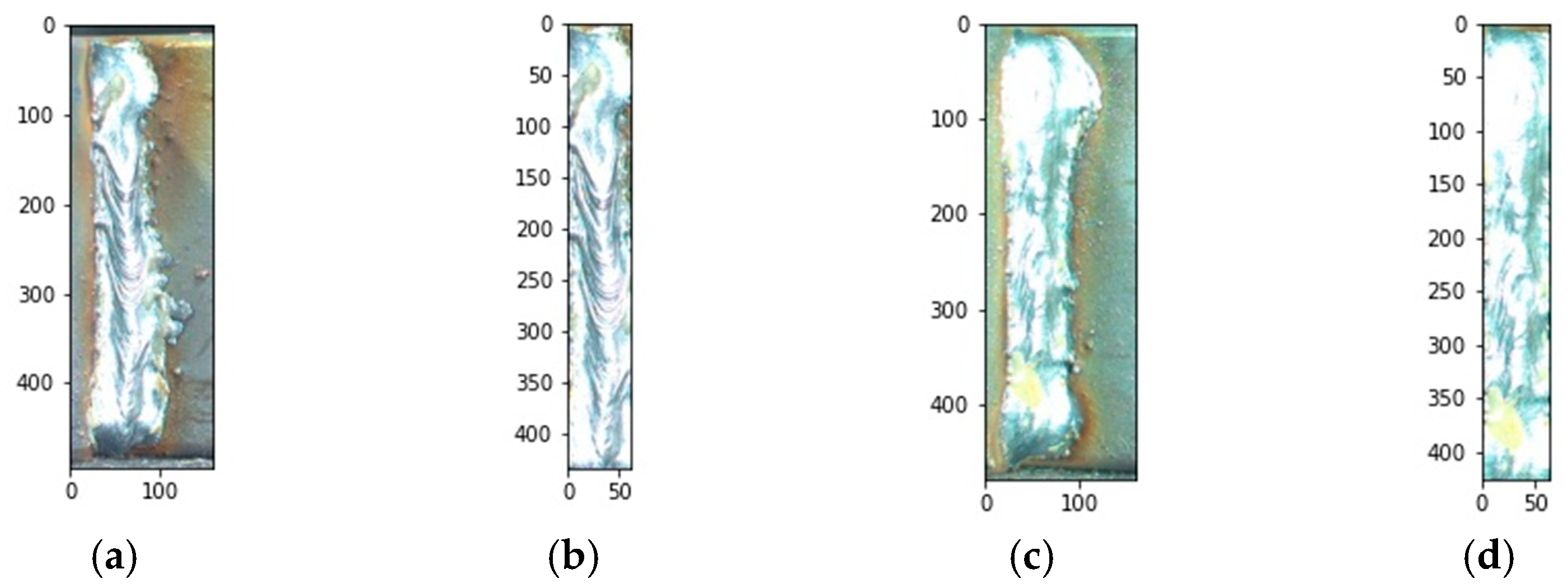

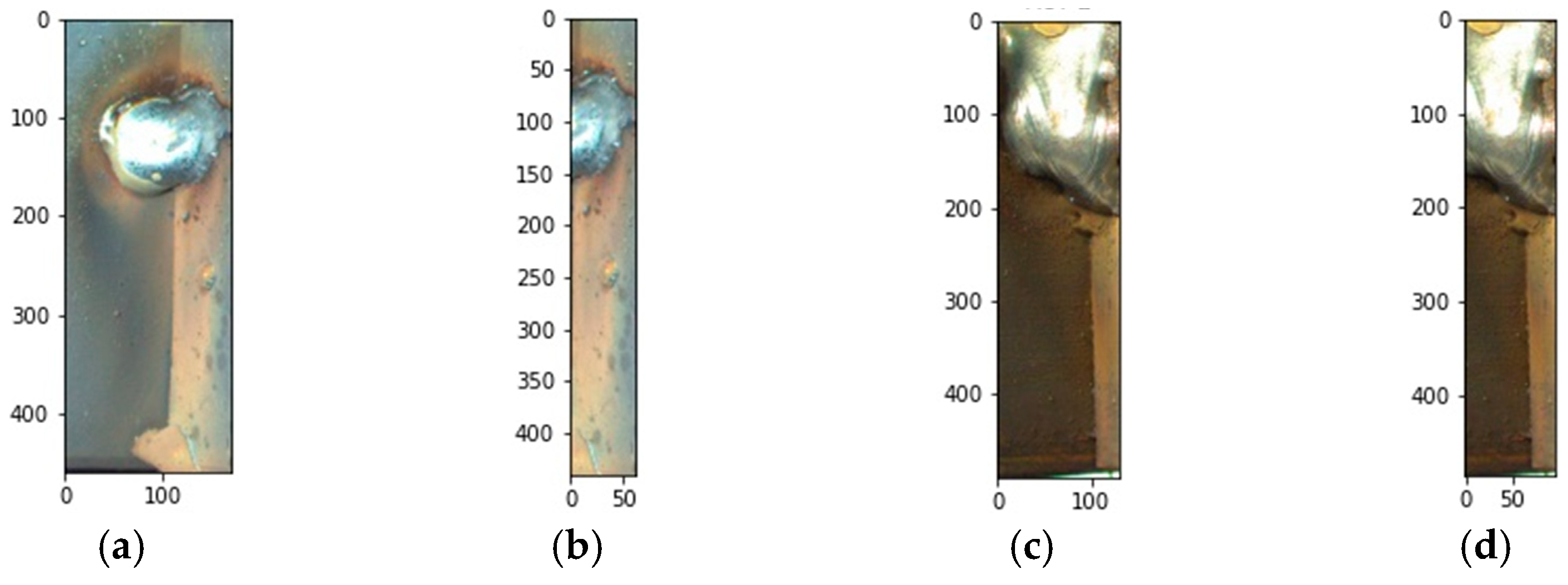
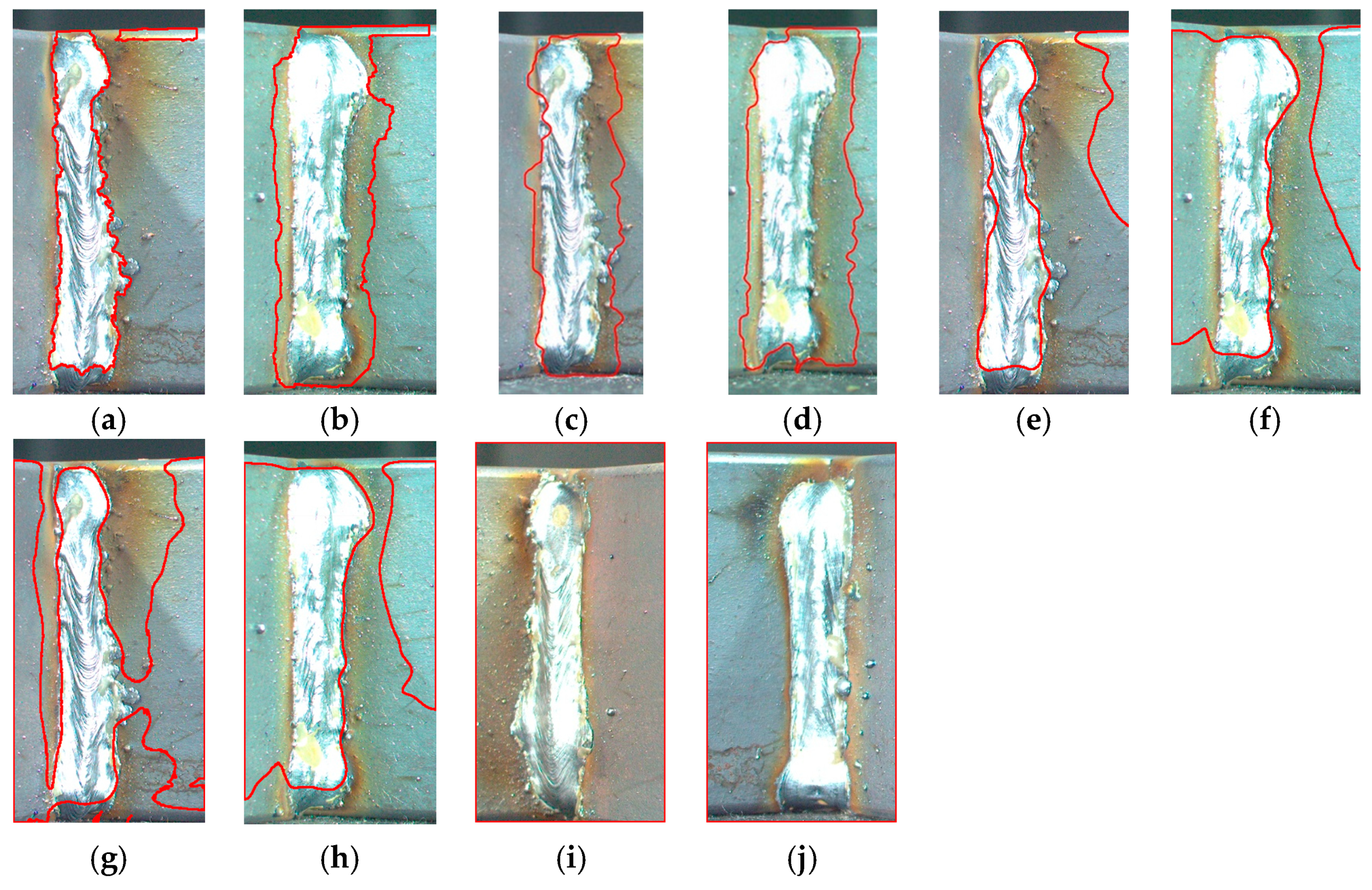
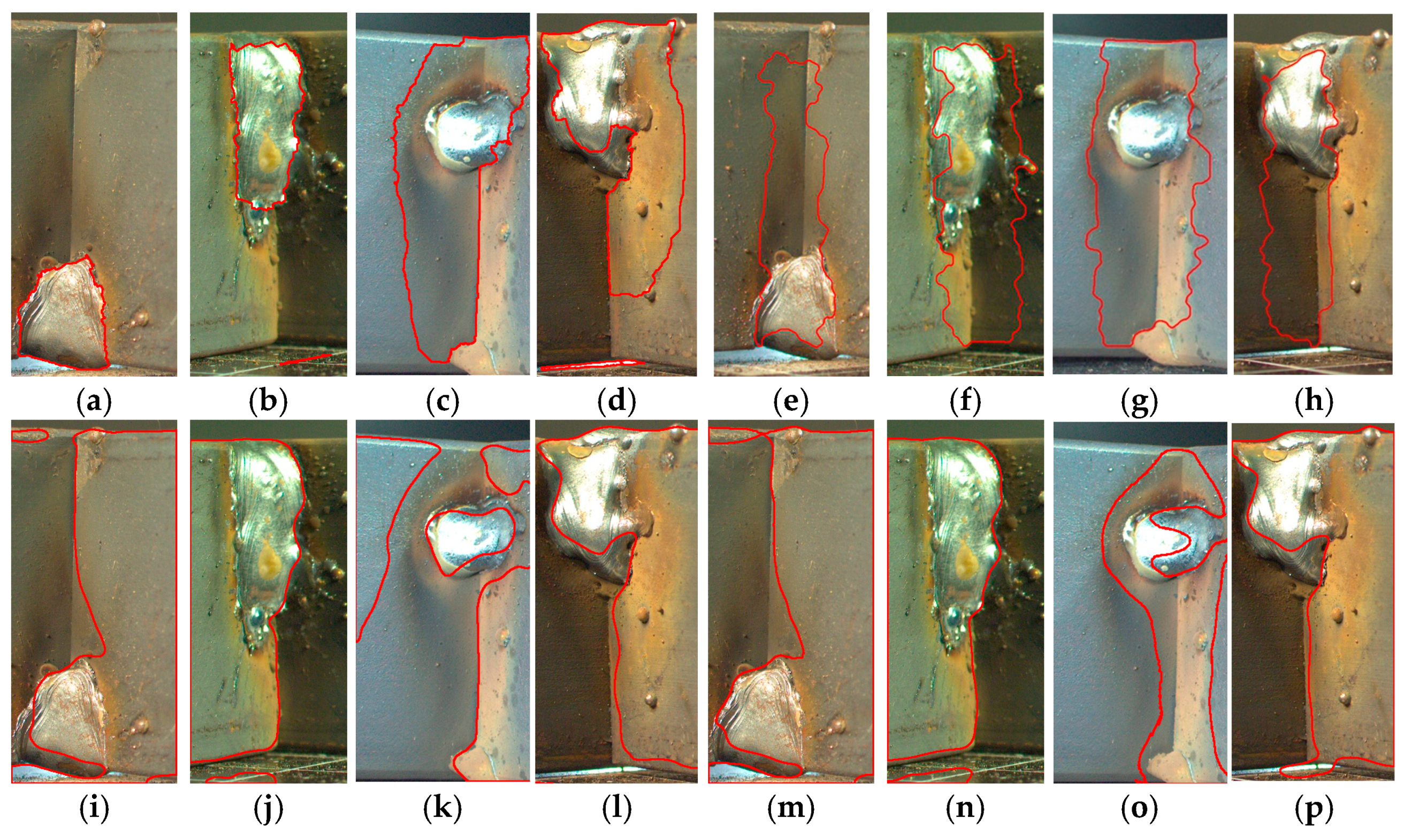
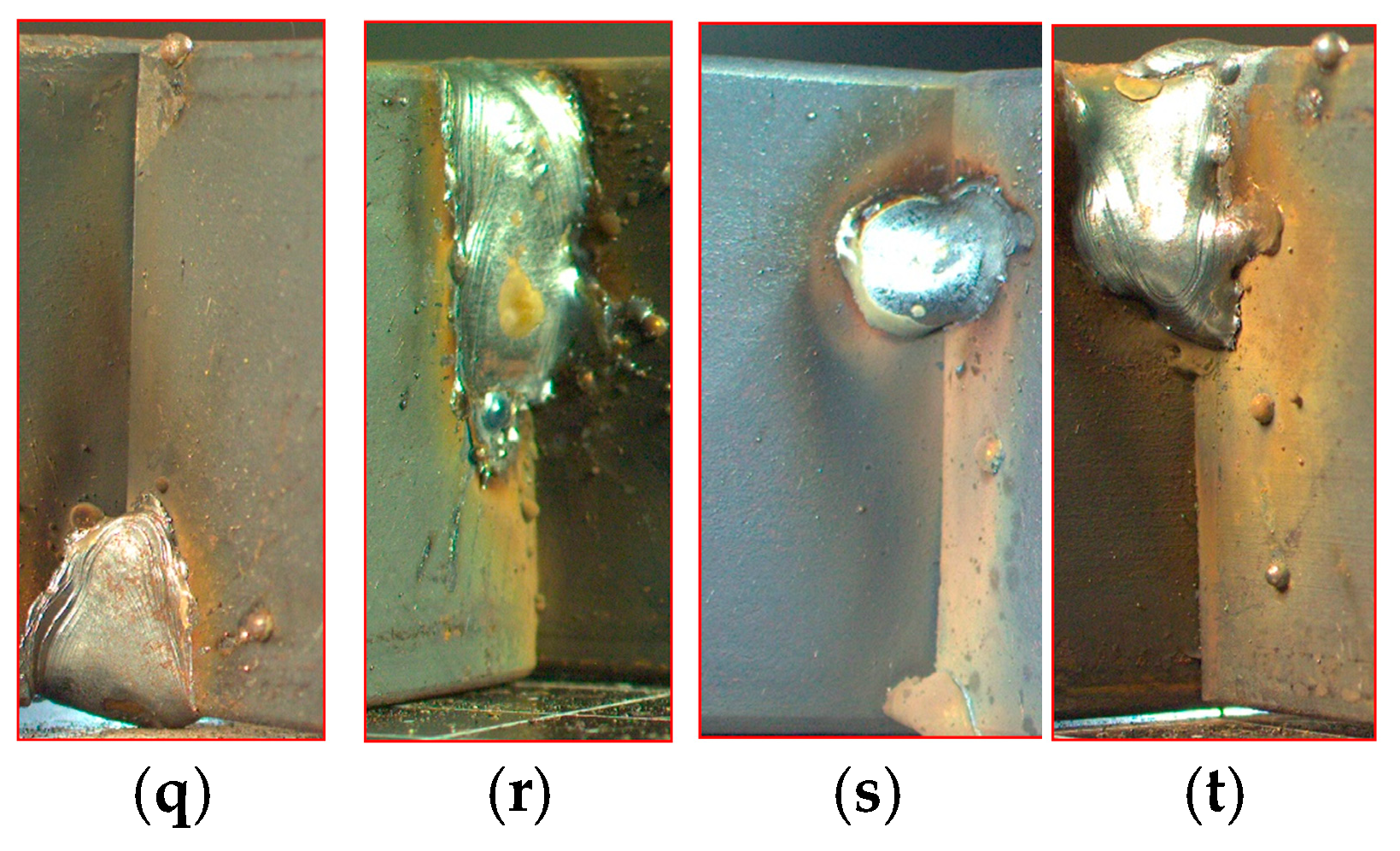
| β | 1 | 3 | 5 | |
|---|---|---|---|---|
| α | ||||
| 0.5 | 93% | 98% | 98% | |
| 0.6 | 83% | 97% | 98% | |
| 0.7 | 66% | 96% | 96% | |
| Inspection | Classification | |||
|---|---|---|---|---|
| TN | FP | FN | TP | |
| Sensor | 11 | 1 | 0 | 480 |
| Image | 10 | 2 | 0 | 480 |
| Sensor and image | 12 | 0 | 0 | 480 |
| Inspection | Accuracy | Precision | Recall | F1 score | Time (s) |
|---|---|---|---|---|---|
| Sensor | 100 | 100 | 100 | 100 | 2 |
| Image | 100 | 100 | 100 | 100 | 27 |
| Sensor and image | 100 | 100 | 100 | 100 | 26 |
| Algorithm | Classification | |||
|---|---|---|---|---|
| TN | FP | FN | TP | |
| Proposed algorithm | 12 | 0 | 0 | 480 |
| Improved Grabcut [20] | 7 | 4 | 0 | 480 |
| Morphological geodesic active contour with Canny [13] | 0 | 12 | 0 | 480 |
| KNN | 0 | 12 | 1 | 479 |
| K-means with HSV [22] | 3 | 9 | 109 | 371 |
| Clustering with the SCA [26] | 0 | 12 | 0 | 480 |
| Algorithm | Accuracy | Precision | Recall | F1 score | Time (s) |
|---|---|---|---|---|---|
| Proposed algorithm | 100 | 100 | 100 | 100 | 25.736 |
| Improved Grabcut [20] | 98.98 | 99.17 | 100 | 99.58 | 690.75 |
| Morphological geodesic active contour with Canny [13] | 97.56 | 97.56 | 100 | 98.76 | 53.88 |
| KNN | 97.36 | 97.56 | 99.79 | 98.66 | 186.72 |
| K-means with HSV [22] | 76.02 | 97.63 | 77.29 | 86.28 | 43.15 |
| Clustering with the SCA [26] | 97.56 | 97.56 | 100 | 98.76 | 1053.73 |
Disclaimer/Publisher’s Note: The statements, opinions and data contained in all publications are solely those of the individual author(s) and contributor(s) and not of MDPI and/or the editor(s). MDPI and/or the editor(s) disclaim responsibility for any injury to people or property resulting from any ideas, methods, instructions or products referred to in the content. |
© 2023 by the authors. Licensee MDPI, Basel, Switzerland. This article is an open access article distributed under the terms and conditions of the Creative Commons Attribution (CC BY) license (https://creativecommons.org/licenses/by/4.0/).
Share and Cite
Lee, J.; Choi, H.; Kim, J. Welding Bead Inspection Using Image and Multi-Sensor Fusion. Appl. Sci. 2023, 13, 11497. https://doi.org/10.3390/app132011497
Lee J, Choi H, Kim J. Welding Bead Inspection Using Image and Multi-Sensor Fusion. Applied Sciences. 2023; 13(20):11497. https://doi.org/10.3390/app132011497
Chicago/Turabian StyleLee, Jaeeun, Hongseok Choi, and Jongnam Kim. 2023. "Welding Bead Inspection Using Image and Multi-Sensor Fusion" Applied Sciences 13, no. 20: 11497. https://doi.org/10.3390/app132011497
APA StyleLee, J., Choi, H., & Kim, J. (2023). Welding Bead Inspection Using Image and Multi-Sensor Fusion. Applied Sciences, 13(20), 11497. https://doi.org/10.3390/app132011497






